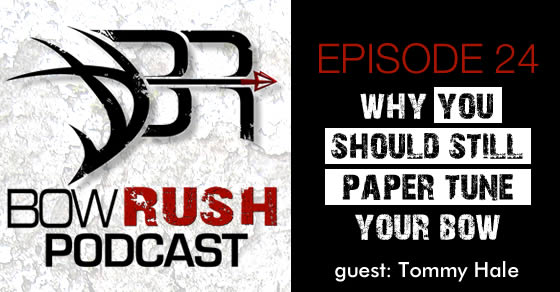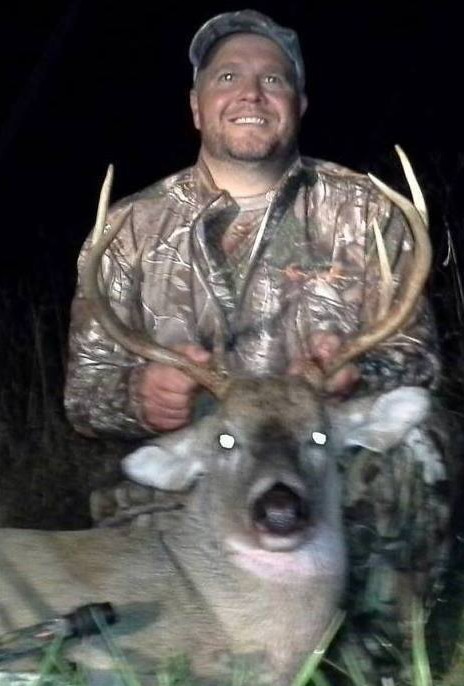Podcast: Play in new window | Embed


Guest – Tommy Hale
In this episode of The BowRush Podcast, I brought Tommy Hale on the show to discuss with me what seems to be a controversial topic: does paper tuning still have a purpose even with today’s compound bows? No matter where you stand on the subject, I believe Tommy gives valid points on why paper tuning can still be a useful method. Tommy and I even talk about other tuning methods such as walk back tuning, bare shaft tuning, modified french tuning. Tommy also discusses how to build your very own paper tuner. This episode was a great continuance from my previous conversation with Justin in Episode #023.
General show notes:
Paper tuning was originally used because the bows back in the day didn’t necessarily have a true center shot which made you have to work around the archer’s paradox. What is an Archery Paradox? It’s when the arrow is binding as it’s going past the riser. The purpose of paper tuning is to insure that we get our arrow leaving the bow as straight as we can.
Paper tuning isn’t the only method; it’s really just a starting point. The cost to build a paper tuner can depend on what you build it with. Tommy believe as long as you can find a way to suspend the paper in a way that the paper has tension on it you should be fine. Note** However you decide to make the paper tuner station, you’ll want to have a very sturdy base to keep the tuner as static as possible otherwise you might get false readings on the tares. A general method archers use today to build the paper tuner is with PVC piping which you can pick up at your local hardware store.
Tommy mentioned Paper Tune-IT Tuning System as a pre-built system for less the $20. You can google to find out more about it and where to purchase.
Types of paper to consider: butcher paper or wax paper/parchment paper.
Other things that paper tuning can help you identify about your bow which are things like cam lean, spine issues with arrows, nock height, cam timing especially on two cam or a binary cam system. Tommy has even identified a bent riser on a bow because of paper tuning.
Paper Tuning Tears: There are 4 main tears.
- Tail Low
- Tail Hight
- Tail Right
- Tail Left
Tommy said that instead of moving your rest around to correct the tear pattern, first start of by turning your yoke on the bow string before you start moving the rest around. Tommy explains how to preform this on the show. It seems simple enough but you will need a bow press.
When paper tuning, you’ll only need your target to be 3 to 4 feed away from your paper tuning station. You want to basically be far enough away so that your arrow has cleared your bow by the time it’s entering the paper.
Tommy believes that no matter which tuning method you choose to do, he personally believes that all these tuning methods need to be done at shoulder level. This will help remove variables in your shot and should give you a more accurate reading.
URL LINKS:
- Facebook Group: Blue Collar Bowhunting: https://goo.gl/S7WNV2
- Tommy Hale Facebook: https://goo.gl/He47Rp
Follow Us On Facebook:
https://www.facebook.com/Mybowrush
Follow Us On Twitter:
http://twitter.com/mybowrush
Follow Us On Google +:
https://plus.google.com/+Mybowrush/posts
Share a badass catchphrase?
If you’ve listened to the whole podcast of each episode, you might have noticed that we added a catchphrase at the end that was sent to use by a listener. The next one could be yours, so comment below and or send us an email with what you come up with and if we like it, we’ll use it.
If you have any questions, feel free to comment below.

 I’m a father to an amazing son. My passion is the outdoors and I love to bow hunt.
I’m a father to an amazing son. My passion is the outdoors and I love to bow hunt.  I currently live in Georgia and am a whitetail fanatic but I recently spent some time in colorado and Utah.
I currently live in Georgia and am a whitetail fanatic but I recently spent some time in colorado and Utah.  Faith, Family, hunting. These are the best ways to describe my life.
Faith, Family, hunting. These are the best ways to describe my life.
Subscribe To Our Newsletter
Join our mailing list to receive the latest episodes, news and updates from our team.
You have Successfully Subscribed!